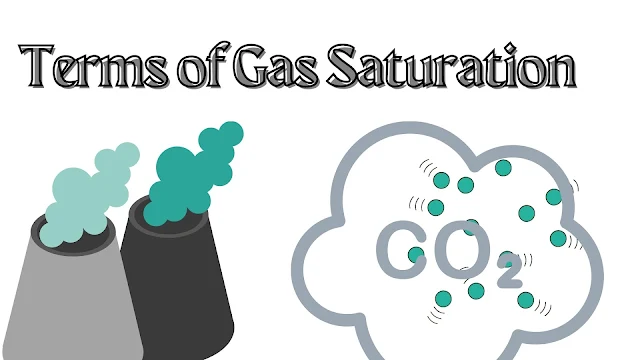When a gas or gaseous mixture comes in contact with a liquid, it takes up vapor from the liquid. This action continues till the vapor pressure of the gaseous mixture at the present temperature becomes equal to the vapor pressure of the liquid, which is called saturation of the gas mixture.
The volume of vapor in a saturated gas is calculated from the following formula.
Vs = V Pv/P
Where
Vs = Volume of Vapours
V = Total Volume
PV = Partial Pressure of Vapour or vapor pressure of the liquid
P = Total pressure
Partial Saturation
If vapor is present in a gas in such a ratio that the partial pressure of the vapor at the present temperature is less than the vapor pressure of the liquid, then the mixture is called partial saturation.
Percentage Saturation and Relative Saturation
Relative Saturation Definition
It is the percentage ratio of the vapor's partial pressure to the liquid's vapor pressure at the present temperature.
Relative Saturation formula
%Relative Saturation = (Pv)/(Ps)X100
Where Pv = Partial Pressure of Vapour
Ps = Vapour pressure of a liquid
Relative Saturation = Pressure weight per unit volume of the mixture at partial saturation / Vapor weight per unit volume of the mixture at saturation
Percentage Saturation Definition
The degree of saturation of a vapor mixture of a gas is called pressure saturation. OR, It is 1% ratio of the weight of vapor present in the vapor mixed gas at the present temperature and pressure and 1% of the weight in the vapor at saturation.
Percentage Saturation Formula
Percentage Saturation = (nv/ns)X100
Where
nv = number of moles of vapour or dry gas
ns = number of moles of vapour of saturation
Saturation Humidity Definition
When the gas is completely saturated with water vapour, the humidity of the gas is called saturated humidity. The partial pressure of this type of vapor becomes equal to the vapor pressure of the liquid at the gas temperature.
The formula of saturation Humidity
Pv = Ps
Hs = 0.6207(Ps/P-Ps)
Critical Saturation
Critical saturation, gas or Vapour, refers to the minimum saturation at which a phase becomes mobile. The endpoint saturation of a phase for a specific displacement process depends on it.
Properties of Real Gases and Ideal Gases
Ideal and real gases are those gases in which the following properties are found.
Ideal Gas Properties
1. Ideal gas has a mass and the volume of its molecules is considered negligible compared to the total volume of the gas.
2. The intermolecular forces between the molecules of an ideal gas are negligible.
3. They cannot be liquefied at normal temperature and pressure.
4. An ideal gas is a hypothetical gas that obeys Boyle's and Charles' laws and Dalton's and Amagat's laws.
Real Gas Properties
1. The gases which have mass. Its molecules have a definite volume and the volume of the gas molecules is not negligible as compared to the total volume of the gas.
2. There are forces of attraction and repulsion between the molecules of these gases.
3. They cannot be liquefied easily.
4. These gases do not obey Bayal's, Charles', Dalton's, and Amaget's laws.

